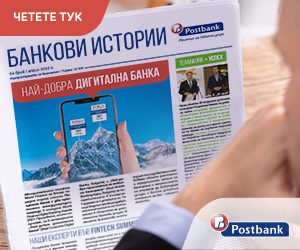Petia Dimitrova: Consumers want convenience with just a few clicks, and we deliver it through our digital products
What are the biggest challenges in the overall transformation of banking processes?
Digital transformation in banking is no longer just about convenience – it’s a necessary condition for sustainability, growth, and long-term competitiveness in an era of accelerated technological evolution and shifting customer expectations. The past few years, marked by various challenges, have undoubtedly acted as a catalyst, accelerating digitalization across all sectors, and banking is no exception. The dynamic development of financial and technological innovations is focused entirely on customer satisfaction and fast, easy, and convenient access to banking services. In recent years, our focus has been on enhancing digital channels and solutions, as well as introducing new ones that transform how we serve customers and manage processes. We launched and are actively implementing the Go-Beyond program – a strategic plan that will transform Postbank and allow us to set new service standards, delivering better and faster services, higher operational efficiency, and flexibility in today’s dynamic environment. Our mission and priority remain delivering exceptional customer experience and high-quality financial services and digital innovations, through continuous process improvement and the use of cutting-edge technologies to ensure security, convenience, and efficiency in every interaction. To meet these challenges, Postbank has invested significant resources in developing mobile banking, improving our online platform, launching the OneWallet digital wallet, and implementing new analytical tools to better understand our customers’ needs.
Have you noticed a shift in customer attitudes toward digital services in recent years?
Yes, absolutely. At Postbank, we’ve observed a steady increase in customer preference for card and online payments, as well as a rise in the use of digitized cards in mobile wallets. Notably, for another consecutive year, the bank has reported a monthly upward trend in debit card transactions, indicating that customers increasingly recognize them as a primary payment method for everyday purchases. This trend obliges us to take responsibility for raising public awareness on key financial topics such as cybersecurity and electronic payments, reaffirming our social responsibility and leadership role. At Postbank, we not only have the right but also the responsibility to be an active player in this space. As a long-standing institution focused on digitalizing financial services, we understand that technological progress only makes sense when it’s accessible and understandable. For us, digital financial literacy is not just CSR – it’s part of responsible modern banking. Young people are both the most vulnerable and the most active group in the digital space, while cybercriminals are becoming increasingly sophisticated and their networks more complex. The only way to counter them is through open and widespread dialogue, along with targeted efforts to improve digital financial literacy in Bulgaria.
Could you share more about these efforts?
We launched a large-scale educational campaign to improve digital financial literacy across the country. The project “Finance under Ctrl” aims to guide users through the virtual space and the world of electronic payments, ensuring their online experience is as safe, convenient, and enjoyable as possible. It teaches them how to protect their personal data and funds and how to recognize various online scams. Through the “Finance under CTRL” initiative, Postbank is actively working to enhance the financial literacy of young people, preparing them for secure and informed use of digital services. We believe that in the digital age, high financial literacy is just as important as technological innovation.
Many Bulgarian customers are traditionally conservative. What convinces them to switch from the counter to online banking or mobile apps?
Digitalization is not just about offering online services – it involves transforming the entire business model through automation, hyper-personalized financial solutions, and proactive service based on real-time data analysis. Postbank is among the pioneers in developing an omni-channel customer strategy – we’re building a connected digital experience where customers can seamlessly transition between mobile apps, digital branches, and self-service zones, all with consistently high service quality. Advanced customer segmentation has enabled us to implement hyper-personalized campaigns – targeted, timely, and fully aligned with each client’s individual preferences and current needs. This is another strong argument in favor of digital channels. That’s why our customers increasingly appreciate the convenience, security, and added benefits that digital channels offer. The sustained growth in these segments is the result of our ongoing efforts to improve customer experience.
Are there specific products or services that will change with the introduction of the single currency?
The banking sector will make the process extremely easy and seamless for all our clients, and they won’t need to take any action to integrate their banking services. Banks have long been working on specific transition plans and compliance with the Euro Adoption Act. This includes IT system updates, customer communications, staff training, free conversion processes, and more. Moreover, we, the banks, have launched active campaigns on our websites. The Association of Banks has also published a Q&A section on its site, and a massive information campaign is underway – including on social media – to help citizens find answers to all their questions.
Looking five years ahead, do you see the bank more as a tech company or a traditional financial institution?
I believe that the combination of technological advancement and traditional banking will drive a more modern, efficient, and accessible banking experience. Undoubtedly, the winners will be those who manage to integrate open banking models and platforms, combining speed, technological expertise, and the ability to create more genuine, accessible, and personalized connections with people.











